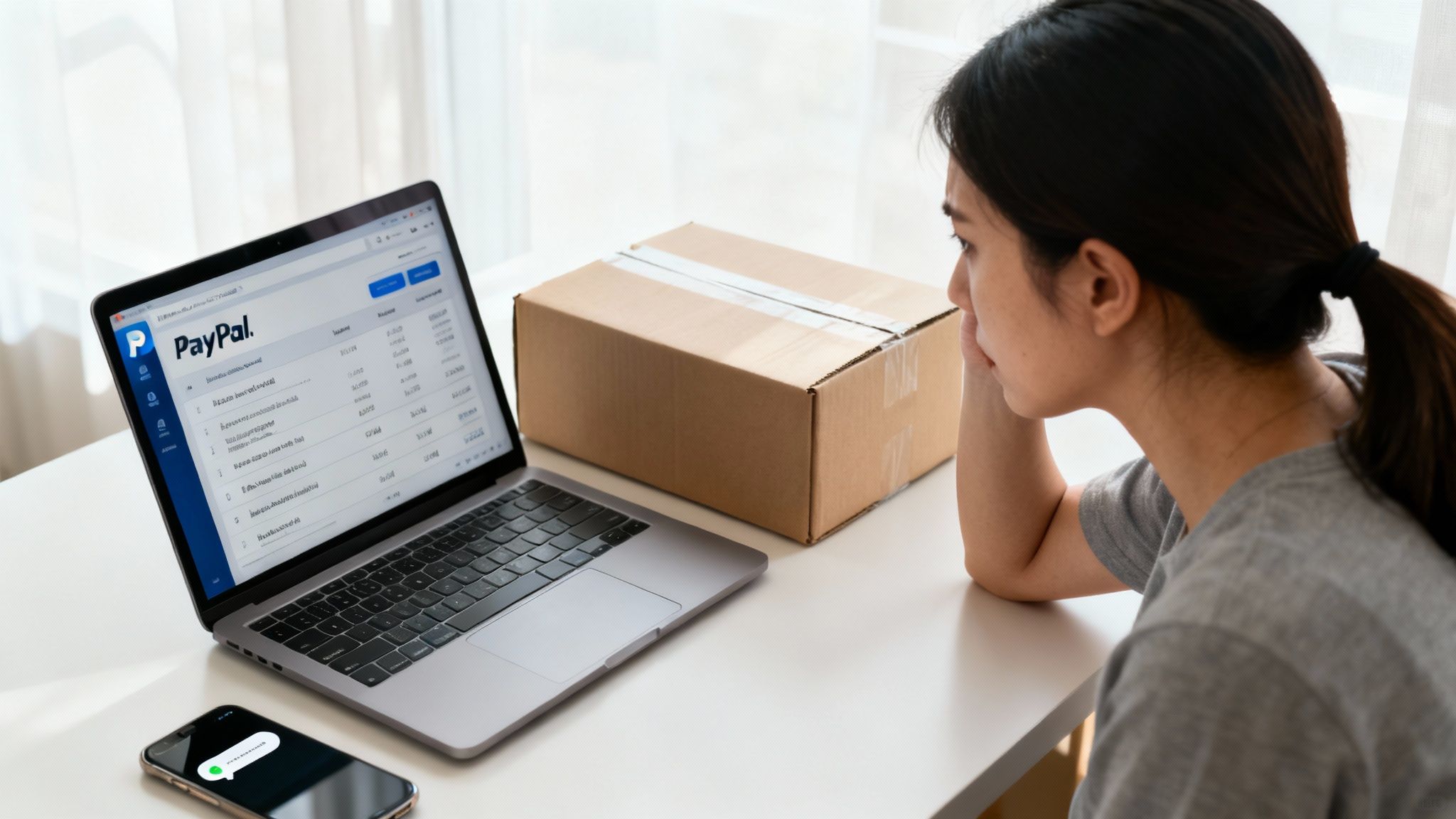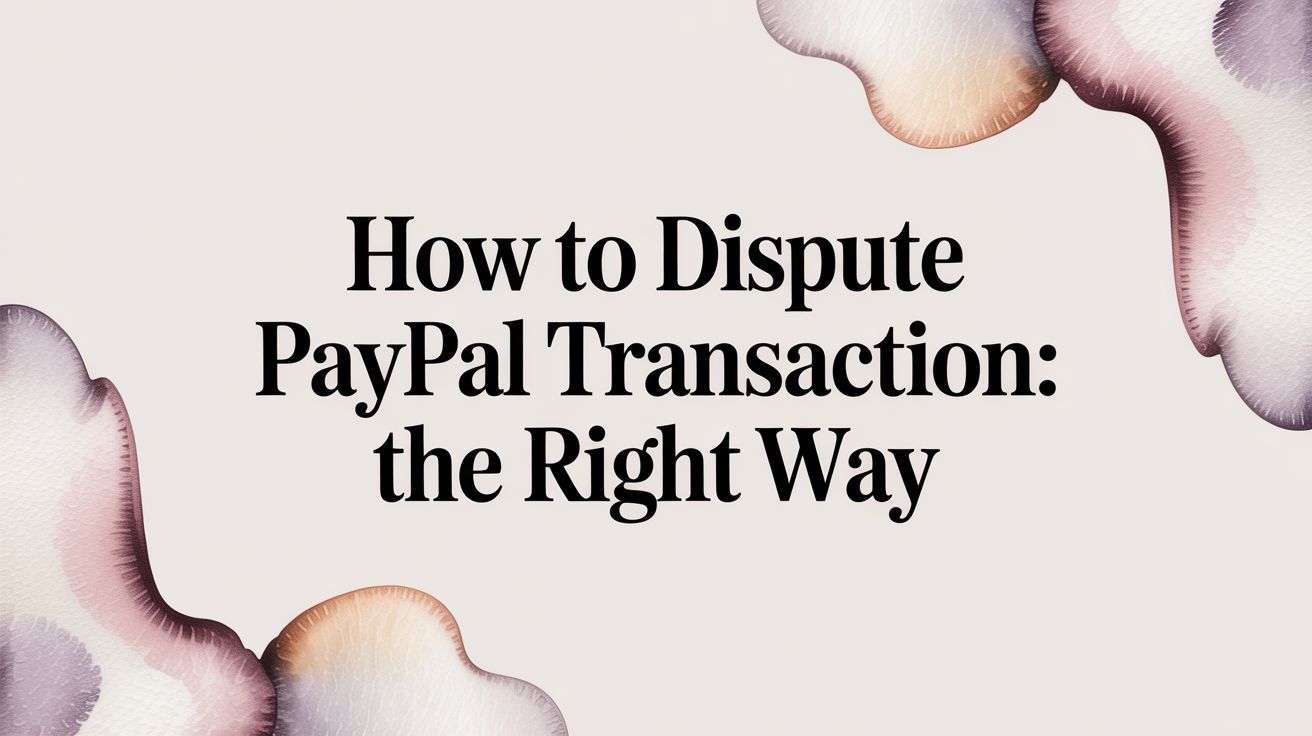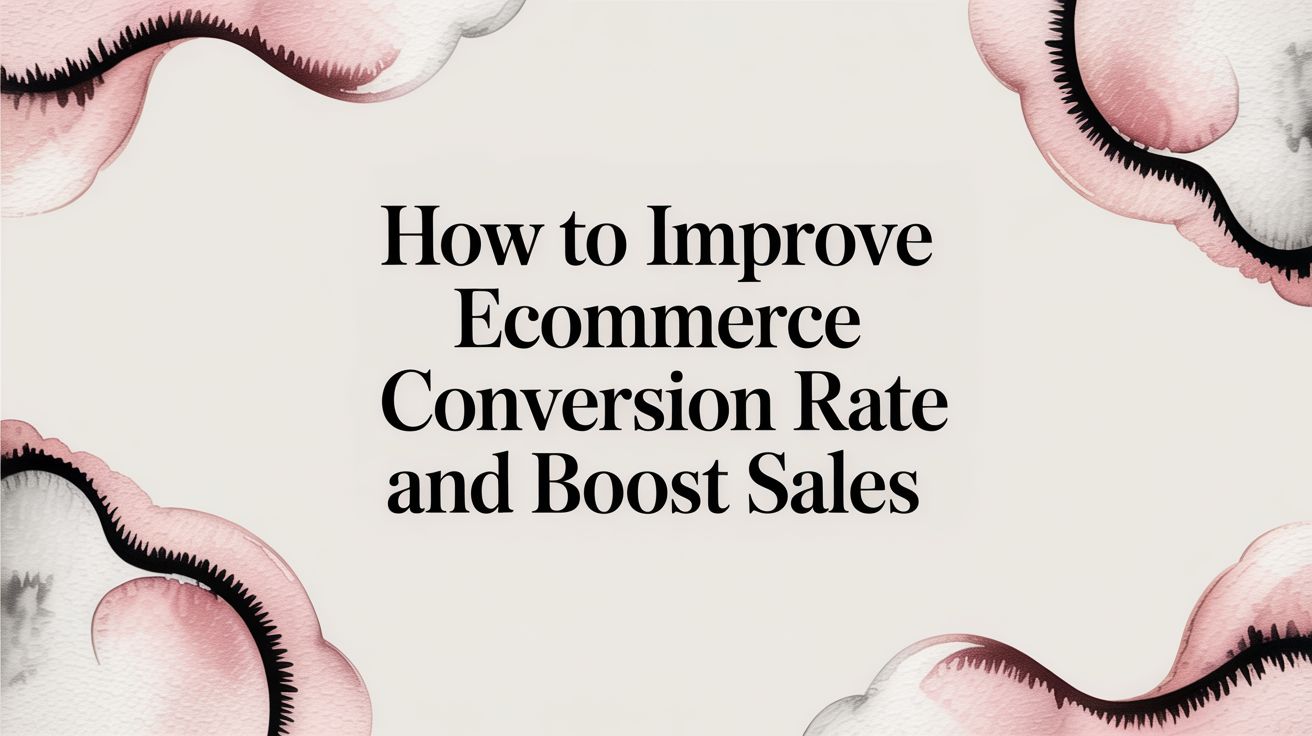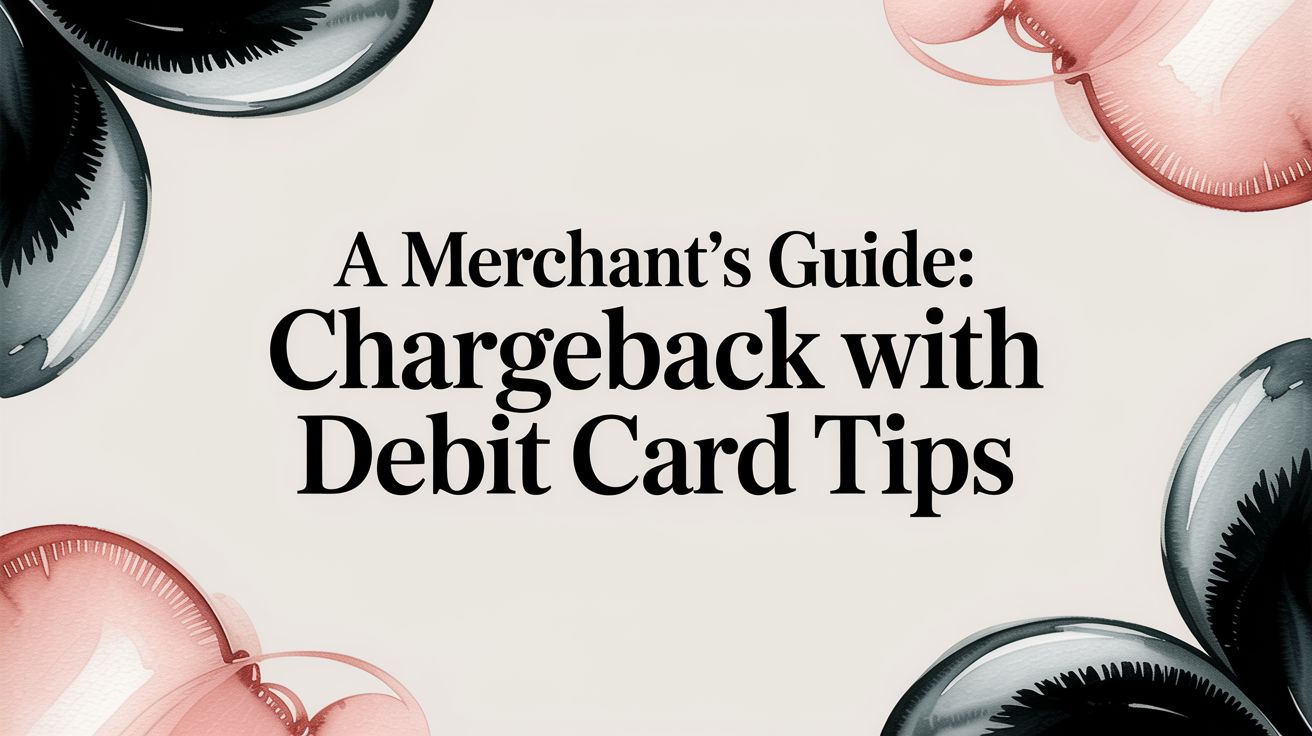
It’s a feeling every online shopper dreads: the package never arrives, or what’s inside is completely wrong. If you paid with PayPal, your first move is to open a dispute in their Resolution Center. This isn't about starting a fight; it's about opening a direct, moderated conversation with the seller to get things sorted out.
What to Do When a PayPal Purchase Goes Wrong

Whether you’re a buyer staring at a broken item or a merchant who just got a dispute notification, how you react first really matters. The whole system is built to give both of you a chance to solve the problem directly before PayPal has to step in and play referee.
If you're the buyer, this is your chance to clearly explain what went wrong. Got a damaged product? Snap a photo and attach it. For sellers, this is a golden opportunity to provide top-notch customer service and fix a simple issue before it snowballs into something bigger.
Understanding Disputes vs. Claims
People often toss around the words "dispute" and "claim" like they’re the same thing, but in PayPal’s world, they’re two very different stages. Nailing this distinction from the get-go is key.
A dispute is the starting point. Think of it as a formal, private chat between you and the seller, all happening within PayPal's system. The goal here is to work it out together. You've got 20 days to find a solution.
If that conversation goes nowhere after 20 days, you can escalate the dispute to a claim. This is you officially asking PayPal to step in, review everything, and make the final call.
A common mistake is assuming a "dispute" immediately starts a refund. It doesn't. It's just a structured conversation. Viewing it as a chance to find a solution—rather than an attack—helps both sides approach it with a much more constructive attitude.
Dispute vs Claim Key Differences at a Glance
To make it even clearer, let's break down the core differences between a dispute and a claim in a simple table.
Understanding this flow helps manage expectations and ensures you follow the right steps at the right time.
The Growing Cost of Transaction Issues
These disagreements are more than just an annoyance; they come with a real financial sting, especially for merchants. In the U.S. alone, every dollar lost to fraud is now estimated to cost merchants a staggering $4.61. That figure has shot up by 37% in just five years, which tells you a lot about how complex payment issues and chargebacks have become.
Of course, the best strategy is prevention. Merchants can get ahead of many potential problems by ensuring every transaction is as smooth and clear as possible. For instance, focusing on things like optimizing your WooCommerce checkout page can go a long way in building trust and minimizing customer confusion right from the start.
When you're unhappy with a purchase, it's one thing to feel frustrated, but another to know exactly what to do about it. If you need to dispute a PayPal transaction, the first few steps you take can really set the stage for how smoothly things go. The good news? Kicking off the process is pretty straightforward.
Getting it right from the jump often leads to a quick fix, letting you avoid the headache of escalating things to a formal claim.
First, Pinpoint the Right Transaction
Everything starts in the PayPal Resolution Center, which is your home base for handling any transaction trouble. But before you can do anything, you need to find the specific payment that's causing the problem.
Log into your PayPal account and go straight to your Activity log. This page lists every transaction you've ever made, so you might need to scroll a bit or use the search filters to zero in on the one you need. Once you find it, click on it to pull up the full details.
You should see an option labeled "Report a problem." Clicking that link is your entry point into the Resolution Center, where PayPal will walk you through the first steps of opening your dispute.
Choose the Correct Reason for the Dispute
This next part is critical. PayPal will ask you to pick a reason for the dispute, and you'll typically see two main options:
- Item Not Received (INR): This is the one you want if you paid for something and it simply never showed up. It covers physical goods that didn't arrive or digital services you were never able to access.
- Significantly Not as Described (SNAD): Pick this if what you got is completely different from what the seller advertised. Think counterfeit products, items that arrived damaged, receiving the wrong thing entirely, or something missing key features.
Nailing this choice from the start ensures your case is routed correctly. For example, if you file an INR dispute for a broken item, it's just going to create confusion and slow everything down.
My two cents: Always be honest and precise here. Don't claim an item wasn't received just because it was a few days late. If it showed up in pieces, SNAD is the correct path. Misrepresenting the situation will only hurt your credibility if PayPal has to step in later on.
How to Write Your First Message to the Seller
After picking a reason, you'll get a chance to send a message directly to the seller. This is your first official communication about the problem, so make it count. The goal isn't to be aggressive—it's to be clear, professional, and factual.
Here’s what a solid opening message looks like:
- For an Item Not Received dispute: "Hello, I'm writing about order #12345, placed on October 26th. The tracking information hasn't been updated in over a week, and the package still hasn't arrived. Could you please check on its status or provide a new tracking number?"
- For a Significantly Not as Described dispute: "Hi, I just received order #67890 for the blue wireless headphones. Unfortunately, the item that arrived is a different model—they're black and wired. They also appear used, with several scratches. I've attached photos showing the differences. I'd like to arrange for a return and a full refund."
By including specific details like order numbers and a calm description of the issue, you give the seller all the information they need to understand the problem and hopefully resolve it quickly. For a deeper look into the specifics of these dispute types, check out these effective strategies for handling PayPal disputes.
Understanding the Dispute and Claim Timeline
Once you decide to dispute a PayPal transaction, a specific timeline kicks in. This isn't something to ignore—missing a deadline could mean your case gets closed automatically, leaving you with no way to get your money back. The clock starts the moment you make the payment.
You have a generous 180-day window from the transaction date to open a dispute. This gives you plenty of time to wait for a delayed shipment or to realize that the "brand new" gadget you bought is anything but. This long timeframe is your safety net, so while you don't need to rush, you definitely don't want to forget about it.
This visual timeline breaks down the key stages of the process, from that initial deadline to the back-and-forth communication and the final resolution.

As you can see, the whole process is built around clear deadlines. These are in place to keep things moving for both you and the seller.
The 20-Day Communication Window
After you open a dispute, a new clock starts ticking. You and the seller now have exactly 20 days to talk things over directly through PayPal's Resolution Center. This is your chance to work it out without getting PayPal involved as a referee.
Think of it as a negotiation period. The seller might offer a partial refund, ask you to return the item for a full one, or finally provide that missing tracking number. The goal here is to find a solution you can both live with. If you want a deeper dive into how these timeframes work, our PayPal chargeback time limit guide covers it all.
But here’s the critical part: if those 20 days go by without a resolution—or if the seller is just ignoring you—the dispute will automatically close. You have to act before that deadline if you're not getting anywhere.
Escalating to a Claim
If you can't come to an agreement within that 20-day window, your next move is to escalate the dispute to a claim. This is you formally asking PayPal to step in, review everything, and make the final call. Don't wait until day 21—you have to do this before the 20-day mark passes.
Once you escalate, PayPal's investigation officially begins. They usually try to resolve claims within 30 days, though some really tricky cases can take a bit longer. During this phase, they might reach out to you or the seller for more information, like photos of a damaged item, copies of receipts, or shipping confirmations.
It's easy to see why managing these timelines is such a massive undertaking for PayPal. With 434 million active accounts worldwide, the volume is staggering. In just one year, its AI-driven tools successfully resolved over 1.5 million disputes, which gives you a sense of the scale you're dealing with.
Ultimately, staying on top of these dates—180 days to open the case, 20 days to negotiate, and escalating before that window shuts—is the key to successfully navigating the process and protecting your purchase.
A Merchant's Guide to Responding to Disputes

That dispute notification email can make any merchant’s stomach drop. We've all been there. But before you panic, take a breath and remember this: how you respond is everything. Acting quickly and professionally—armed with the right evidence—can turn a potential loss into a resolved issue, and maybe even keep a customer.
Your very first move should always be to log in to the PayPal Resolution Center. Don't put it off. The clock starts ticking the moment that dispute is filed, and a prompt response shows you're on top of your business. Inside, you'll see exactly why the buyer filed the dispute—usually "Item Not Received" or "Significantly Not as Described"—along with their initial message.
Gathering Your Strongest Evidence
Let's be clear: your response is only as good as the proof you provide. PayPal deals in facts, not feelings. Your mission is to build a clear, logical case that directly shuts down the buyer's complaint with undeniable evidence.
Start pulling your documents together immediately. The specific proof you'll need depends on the reason for the dispute:
- For "Item Not Received" disputes: Your silver bullet is proof of delivery. This means a valid tracking number from a major carrier (like USPS, FedEx, or UPS) showing the package was successfully delivered to the exact address on the PayPal transaction details page. No exceptions.
- For "Significantly Not as Described" disputes: These are a bit more nuanced. You need to prove the item you sent was exactly what you advertised. Your best evidence will be things like photos of the item before it was packed, a copy of the original product listing with all descriptions and specs, or even email exchanges where the customer confirmed specific details.
A professional and organized response can make all the difference. Think of it like you're putting together a mini-dossier for the transaction. The easier you make it for the PayPal reviewer to see your side of the story, the better your chances are of winning.
Crafting a Clear and Professional Response
Once you have your evidence lined up, it's time to write your response in the Resolution Center. Keep it short, factual, and polite. This is not the place for emotional language or arguing with the customer. Just stick to the point.
A good approach is to acknowledge the customer's issue, then systematically present your evidence to counter it. For more complex situations, structuring your response like a formal rebuttal can be incredibly effective. If you need some pointers, you can find useful examples of how to write a rebuttal letter for a dispute that can help you frame your argument.
This is also a good time to think about your international sales strategy. Cross-border transactions often have higher dispute rates due to things like shipping delays, customs hold-ups, or different customer expectations. In fact, U.S. merchants with a lot of international sales can see dispute rates climb as high as 11%.
Preventing Future Disputes
Honestly, the best way to handle a dispute is to stop it from ever happening in the first place. A little proactive effort can save you a ton of time, money, and stress down the road.
Simple actions can make a huge difference:
- Write painfully detailed product descriptions. Be brutally honest about the item’s condition, size, color, and features. Leave no room for interpretation.
- Use high-quality photos. Show the product from every conceivable angle so buyers know exactly what they're getting.
- Communicate like your business depends on it. Send shipping confirmations with tracking numbers the moment the label is printed.
- Offer lightning-fast customer service. Answer questions quickly and address any concerns before they have a chance to escalate into a full-blown dispute.
Merchants can also gain a serious eCommerce advantage for small businesses by building out robust online selling platforms that help prevent common transaction problems. By creating a clear, trustworthy, and transparent buying experience from the start, you build customer confidence and slash the odds of a simple misunderstanding turning into a formal dispute.
When and How to Escalate to a PayPal Claim
Sometimes, talking it out with the seller just doesn't work. You’ve given it your best shot within that 20-day dispute window, but you’re getting nowhere. Maybe the seller has gone completely silent, or they've offered a "solution" that's frankly insulting.
This is exactly why PayPal has an escalation process. When you’ve hit a wall, it’s time to stop the back-and-forth and let PayPal take the reins.
Escalating your dispute to a formal claim is your next—and most important—move. It’s a signal to PayPal that you’ve tried to resolve things directly and failed. But timing is everything. You absolutely must escalate before the 20-day dispute period is up. If you miss that deadline, the case closes automatically, and you’ve lost your chance for good.
Knowing When It Is Time to Escalate
It can be tough to know when to pull the trigger, but don't let a difficult seller drag things out until your time runs out. There are some classic red flags that tell you it's time to act.
You should escalate to a claim if the seller:
- Goes dark. If a few days have passed and your messages are met with silence, they're probably hoping you'll just go away.
- Offers an unreasonable fix. A $5 partial refund for an item that arrived shattered isn't a resolution; it's an insult.
- Gets hostile or uncooperative. Once the conversation breaks down and gets unprofessional, the odds of a friendly resolution are slim to none.
- Keeps making empty promises. Stalling is a classic tactic. If they keep saying they'll "look into it" but never deliver, they're just running out the clock.
If you find yourself in any of these scenarios, it’s time to take your dispute PayPal transaction to the next level.
The Escalation Process and Building Your Case
Turning your dispute into a claim is actually pretty simple. Head back to the case in your Resolution Center and look for a button that says something like "Escalate to a claim." Once you click that, PayPal's own team officially takes over the investigation.
From this point on, your audience is no longer the seller—it's PayPal’s review team. Your job is to build a rock-solid case file that clearly proves your side of the story.
Your goal is to make it as easy as possible for the PayPal reviewer to understand what went wrong. Present your evidence clearly and chronologically. A well-organized claim is much more likely to be successful than a jumbled collection of complaints.
Gather up everything you have. This includes:
- Photos or videos that clearly show the problem (e.g., the damage, the wrong item next to the order confirmation).
- Screenshots of all your messages with the seller.
- Copies of any relevant receipts, invoices, or even the original product listing.
Upload all this evidence directly to the claim page. The clearer and more compelling your proof is, the stronger your case will be. For more details on where this all happens, you can find helpful info in the PayPal Dispute Resolution Centre, which is the hub for managing these cases.
After you've submitted everything, PayPal will review the evidence from both you and the seller and make a final decision, which usually takes about 30 days.
Getting Into the Weeds: Common PayPal Dispute Scenarios
Alright, let's move past the textbook process and talk about the real-world messes that lead to PayPal disputes. Every situation is unique, and knowing how to navigate your specific problem can mean the difference between getting your money back and writing it off as a loss.
The trick is to match your evidence to the specific issue. Think of yourself as a detective building a case for your own purchase—the more clues and proof you provide, the clearer the picture becomes for PayPal when they step in to review a claim.
Scenario 1: Your Item Shows Up Damaged or Broken
This is a classic "Significantly Not as Described," or SNAD, case. You ordered a pristine vinyl record, but it arrived looking like it was used as a frisbee. Your very first move should be to message the seller directly with clear, undeniable proof of the damage.
Here’s the evidence you’ll want to gather:
- Photos of the packaging: Was the box crushed, torn, or poorly packed? This helps show the damage might have happened in transit.
- Multiple photos of the item: Get shots from several angles, focusing on the damage. A short video can be even more compelling.
- A screenshot of the original listing: This is your proof that you bought an item described as "new" or "in excellent condition," not "pre-cracked."
Don't just say, "It's broken." Get specific. Something like, "The screen on the phone has a large crack across the top left corner that wasn't mentioned in the description. I've attached photos showing the damage."
Scenario 2: The Item Never Arrives
This is easily the most frequent reason to dispute a PayPal transaction, and it falls under the "Item Not Received" (INR) category. You've waited patiently, the tracking number has been stuck in limbo for a week, and the seller has gone silent.
Your main goal here is to demonstrate to PayPal that you did your part. Keep a record of every message you sent the seller asking for an update. The burden of proof is mostly on the seller to provide a valid tracking number showing it was delivered to your address.
For a deeper dive on this specific problem, check out our guide on what to do for item not received PayPal disputes for more practical next steps.
Here’s a common pitfall: buyers get impatient and close a dispute early because a seller promises the item is "just around the corner." Don't do it. Keep that dispute open until the package is physically in your hands and you've confirmed its condition.
Scenario 3: You Spot an Unauthorized Transaction
This one is much more serious. If you see a payment in your PayPal activity that you know you didn't make, you need to act immediately. This isn't your typical buyer-seller spat; it's a potential security breach.
Forget opening a standard dispute. You need to report it as an unauthorized transaction right away. PayPal has a separate, more urgent process for these cases. Be ready to confirm your identity and change your password and security questions to lock down your account. Do not engage the "seller"—report it directly to PayPal's fraud team.
Scenario 4: A Digital Product Isn't Delivered
So, what happens if you bought an ebook, a software key, or access to an online course and got nothing? Disputing digital goods can feel tricky because there's no physical item or tracking number.
In this scenario, all your evidence will be digital. You need to collect screenshots of everything: the original purchase confirmation email, any follow-up messages you sent the seller asking for the product, and proof you never got access (like a login page that rejects your credentials). The more you can document your attempts to get what you paid for, the stronger your claim will be.
PayPal Dispute FAQs: Your Questions Answered
When you're dealing with a payment problem, a lot of questions can pop up. Let's get right to it and clear up some of the most common things people ask when they hit a snag with a PayPal transaction.
Can I Dispute a Friends and Family Payment?
Straight answer: no. PayPal's Purchase Protection is great, but it specifically doesn't cover money sent using the "Friends and Family" option.
That method is built for personal transfers—think splitting a dinner bill with a buddy or sending a cash gift. It’s not for buying goods or services. Because it sidesteps the commercial transaction process, those payments are typically final and can't be disputed.
How Long Does PayPal Take to Resolve a Claim?
Once you've escalated your issue from a simple dispute to a formal claim, PayPal usually tries to wrap things up and make a final call within 30 days.
Keep in mind, that's a general timeline. If your case is a bit more complicated or they need extra info from you or the seller, it can sometimes take a little longer. You won't be left in the dark, though—PayPal will send you email updates as their investigation moves forward and when they've made a decision.
A common myth is that opening a dispute instantly kills the transaction. It doesn't. It's really just a structured way to talk things out. One user mentioned they opened a dispute just to question a double charge, and the merchant panicked and canceled their non-refundable booking. It’s a good reminder to be super clear about what you’re trying to achieve with the dispute.
What Happens if I Lose the Dispute as a Buyer?
If PayPal sides with the seller, the case is closed for good. You typically can't reopen it for the same transaction. The money stays with the seller, and that's the end of the road as far as PayPal is concerned.
But you're not totally out of options. Your next move is to contact your bank or credit card company directly. Many of them have their own purchase protection or chargeback processes you can use, even after losing a PayPal claim. It gives you another potential shot at getting your money back.
Manually fighting chargebacks is a huge time sink. ChargePay uses AI to build and send winning responses for your PayPal disputes automatically. You can recover up to 80% of your lost revenue without doing any of the heavy lifting. See how it works at https://www.chargepay.ai.






.svg)







.svg)
.svg)
.svg)